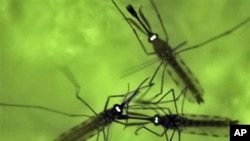An international team of scientists has developed a way to genetically modify the malaria mosquito so that it would be unable to transmit the disease to humans. Researchers say the method eventually might be used to control large populations of mosquitoes by releasing a small number of modified insects into the wild that could breed the trait into ensuing generations.
For the past 10 years, researchers have been attempting in the laboratory to biologically alter the malaria mosquito, known as Anopheles gambiae, so it can’t breed and spread the parasitic illness, as well as several other diseases.
Malaria affects more than 300 million people around the world every year, killing nearly 800,000 people, most of them children.
The goal of the latest research, according to parasitologist Andrea Crisanti of Imperial College London, is to control the female mosquito - which spreads the disease by biting humans - without having to resort to chemical pesticides, which can be harmful to people and the environment.
“The path that we have chosen is to develop mosquitos that are eventually resistant to malaria and they spread that resistance gene to local populations [of mosquitoes]. So, in principal, they do the job for us,” said Crisanti.
Crisanti led a team of British, U.S. and Japanese researchers that inserted a unique segment of genetic material, or DNA, into the chromosomes of the malaria mosquito.
The DNA segment, known as a “selfish gene,” produces an enzyme that inactivates specific genes and replaces them with copies of itself.
In laboratory experiments, the researchers mated a small number of male mosquitoes carrying the selfish gene with female insects bred to carry a fluorescence gene that made them glow green for easy identification.
At the start of the experiment, 99 percent of the mosquitoes had the green tag. Just one percent had the selfish gene.
Within a dozen generations, Crisanti said, more than half of the Anopheles mosquitoes lacked the green tag, after acquiring the male mosquitoes’ selfish gene.
“So in this way, generation after generation of the progeny carries the genetic modification and this has increased exponentially. And in a span of 12 generations, which is more or less the time span of the rainy season of a malaria endemic country.”
The results are what are called a proof of principle - scientists have showed it is possible to use genetic engineering to control populations of malaria mosquitoes.
Previous control efforts have involved sterilizing male mosquitoes with radiation and releasing millions of them to mate with females in the wild so they cannot produce fertile offspring. But they have not worked very well. Experts say the female Anopheles prefers to breed with wild male mosquitoes.
Chrisanti said the research team’s goal now is to work on specific Anopholes genes that are essential to its transmission of the malaria parasite. The team already has identified 10 candidate genes, including an odor-recognition gene that helps mosquitoes locate their human hosts, and a gene that permits the malaria parasite to enter the mosquito’s salivary gland.
An article on genetic manipulation of the Anopheles mosquito for malaria control is published this week in the journal Nature.
Scientists Use Genetic Technique to Control Malaria Mosquito










